In Wroclaw, Poland is a lively terraced house that reflects the youthful energy of the couple who owns it. Designed by Znamy się for the owners, and their two dogs, who love to cook, entertain friends, and play board games. Drawing inspiration from the whimsical world of Playshapes (wooden blocks that can be moved, layered, or combined), this modern home now boasts a fusion of structures, forms, and vibrant colors that bolster creativity, socializing, and play.
The new interior holds many elements that allow the owners to play with form. Moveable furniture sets the stage with shelves on wheels that enable the couple to create flexible arrangements and new spaces. The kitchen island is not only the place for food prep and cooking, it stores board games and houses water dispensers for their beloved dogs. The dining table’s top lifts to play games and work puzzles.
Geometric shapes and a strong palette of colors intertwine forming layered spaces rich in textures and visual intrigue. The inclusion of lots of wooden elements gives nod to Playshapes, while adding organic charm.
Three shelves set within a blue painted alcove hold a large selection of plants and objects for a touch of biophilia.
The square dining table lives under one of the hanging grids that holds plants. Similar gridded structures live alongside the wooden staircase adding a pop of color while providing safety for those climbing the stairs.
The bathroom features similar wooden cabinets as the kitchen island with geometric patterns adorning the fronts. An inset cabinet is painted a playful pink on the inside, pairing nicely with the black and white floor tile.
Photography by Migdal Studio.
Off the southern tip of South America, the remote and rocky Falkland Islands are home to one of the oddest birds of prey in the world: the striated caracara, which looks like a falcon but acts more like a parrot. Charles Darwin had to fend these birds off the hats, compasses, and valuables of the Beagle; the Falkland Islands government had a bounty on their “cheeky” beaks for much of the 20th century; and modern falconers have used their understanding of language to train them to do dog-like tricks. The other nine species of caracara that span the rest of South America are just as odd in their own ways. In his new book, A Most Remarkable Creature, Jonathan Meiburg follows their unusual evolutionary path across the continent and describes his encounters with these birds over the past 25 years. He joins us from his home in Texas to introduce us to some new feathered friends. This episode originally aired in 2021.
Go beyond the episode:
Tune in every week to catch interviews with the liveliest voices from literature, the arts, sciences, history, and public affairs; reports on cutting-edge works in progress; long-form narratives; and compelling excerpts from new books. Hosted by Stephanie Bastek.
Subscribe: iTunes • Feedburner • Stitcher • Google Play • Acast
Download the audio here (right click to “save link as …”)
Have suggestions for projects you’d like us to catch up on, or writers you want to hear from? Send us a note: podcast [at] theamericanscholar [dot] org. And rate us on iTunes!
The post The Falcon’s Odd Little Cousin appeared first on The American Scholar.
Take any international trip, and the tourist-trap restaurants near the must-see landmarks will all be hawking the “national dish” you simply can’t miss: Greek souvlaki, Japanese ramen, Italian pasta, Mexican mole. Leaving aside the question of whether a restaurant with a laminated English menu could possibly serve good food, we must ask what makes a dish “national”—must it be an old recipe? A common one? Unique to that place? Anya von Bremzen poses these questions and more in her new book, National Dish: Around the World in Search of Food, History, and the Meaning of Home. Beginning in Paris with the 18th-century inauguration of modern French cuisine—and searching for the invention, or perhaps congelation, of pot-au-feu—von Bremzen travels across oceans and continents in search of what defines a country’s cuisine, unraveling notions of identity, nationhood, and politics in the process.
Go beyond the episode:
Tune in every week to catch interviews with the liveliest voices from literature, the arts, sciences, history, and public affairs; reports on cutting-edge works in progress; long-form narratives; and compelling excerpts from new books. Hosted by Stephanie Bastek.
Subscribe: iTunes • Feedburner • Stitcher • Google Play • Acast
Download the audio here (right click to “save link as …”)
Have suggestions for projects you’d like us to catch up on, or writers you want to hear from? Send us a note: podcast [at] theamericanscholar [dot] org. And rate us on iTunes!
The post Imagined Cuisines appeared first on The American Scholar.
I love Creative Commons, ok? I’ve followed, used, the licenses since the start, I have the t-shirts. And like many, I can rattle of the stack of letters and explain them.
But in my internet roaming, especially for my other strong interest, photography, I come across things in practice, well, that are much less cut and dry. Like a few posts ago when I fell into some slimy and weird toy spaces of public domain (not strictly CC, but in the same neighbourhood).
And I also love cacti. They are unworldly, especially to an east coast born suburban kid (well I did taste the Southwest through Roadrunner cartoons), but so intriguing in design and beauty that defies the probably of life with almost no water.
Both seem simple from afar, yet different up close, and occasionally you might get stuck by a sharp spine.
Have I exhausted the un-necessary metaphor? I can’t resist, this was my photo I found my searching my flickr stream on “details”.
On with the show.
Old man internet warning- this started while reading my RSS feeds in my folder of Photography sites. I clicked to read the PetaPixel article Generative AI is a Minefield for Copyright Law. Of course it opens with the requisite surreal AI generated image, but frankly does not really give me anything new beyond what I’ve read before– especially from those great CC folks. Bottom line, no one can really say for sure where the clear rules and guidelines will land on generative imagery. It’s messy. Again.
But this is where it got me curious. Down at the credits bottom of the PetaPixel article it reads:
The opinions expressed in this article are solely those of the author. This article was originally published at The Conversation and is being republished under a Creative Commons license.
https://petapixel.com/2023/06/18/generative-ai-is-a-minefield-for-copyright-law/
It is “being republished under a Creative Commons license”. What license is “a”? And where is the link to the license? I am an observer of attribution practice, and this one falls way short of the Creative Commons Best Practices. Okay, that’s just being sloppy. I am no perfectionist.
But I am curious.
I follow the one link to the original article published at The Conversation (I have read many great articles there, good writing happens, I declare). What’s curious here is I can find no mention of a Creative Commons license on the article. There is a footer assertion "Copyright © 2010–2023, Academic Journalism Society" — so I did around for more.
Not that it would ever be clear to look for license details under a link for “Republishing Guidelines” there it is.
We believe in the free flow of information and so publish under a Creative Commons — Attribution/No derivatives license. This means you can republish our articles online or in print for free, provided you follow these guidelines:
https://theconversation.com/ca/republishing-guidelines
The belief in free flow of information is a nice sentiment. And there is is, they are asserting a CC BY-ND license across their publications. One license to rule them all.
Except.
The conditions.
Now this was somewhat new to me, but I heard the smart and esteemed Jonathan Poritz (certified facilitator of the Creative Commons Certificate) say in an online license quibble that adding extra conditions to a CC license… nullifies it (?) That seems to be clear on the response on the CC Wiki to the question “What if I want to add some conditions and I clarify what I mean by a specific term? Is there anything wrong with adding conditions on top of a CC license?” though the details written under License Modification fall into the Ask a Lawyer region.
Back to the conditions on The Conversation’s site- the first three seem to be the scope of the CC BY-ND license: “You can’t edit our material” (that’s ND), “You have to credit authors and their institutions” (that’s attribution), “You have to credit The Conversation and include a link back to either our home page or the article URL” (also mostly standard attribution).
The question to be is the next one:
You must use our page view counter when republishing online. The page view counter is a 1 pixel by 1 pixel invisible image that allows us and our authors to know when and where content is republished.
https://theconversation.com/ca/republishing-guidelines
Can they really make that a condition of reuse? To deploy a tracking pixel?
That smells a bit weird to me, along with there being no clear indication of the CC ND license directly on articles (hence why PetaPixel does not know what license to declare??).
Okay, this is truly quibbling, but thinking about these details is important, more than just a simple pat acceptance of the basic rules of licensing.
For a recently published post I sought an image of a well known brand of candy– it’s not surprising of course that there are not many available- funny in that my google image search filtered for CC licensed results, a high ranking one was my own flickr photo of the spanish language version I spotted in Mexico (and likely that might be a copyright infringement, shhhh).
The one I liked (and used) was pointed from Google to rawpixel. There’s a great image! But zoom in close, and there’s some fishy things happening.

I am very familiar with the iconic roadside Americana photos of John Margolies, readily available public domain content from the Library of Congress.
Rawpixel does declare the image source (not linked) and the CC0 license. All kosher. So far.
But try to download the image- you are required to create an account. Even free, why do I have to sign up for an account to access public domain content (hint, the upsell answer is in the lower right corner). So rawpixel is repackaging public domain content but putting a requirement to download.
I can right control click and download easily (I did) and that trick of hiding images in a .webp file format is no barrier (Preview on OSX now converts it easily to JPEG).
But there’s more. What is that Editorial Use Only link, right below the link to the CCO license?
Content labeled “Editorial Use Only” are for use in news and events-related articles, non-commercial blogs and websites, broadcasts and other non-profit media. This content cannot be used for commercial purposes including advertising, promotions and merchandising.
Editorial content should not be edited or altered substantially from the original image.
rawpixel.com
Now wait a minute- how can Rawpixel put extra conditions on CC0 content? I’d say this is enforceable as wet tissue.
Compare this to the source of this same image at the Library of Congress. No logins required, the images are directly there in usable JPEG format, and there are no extra conditions.
The question is- why does Google give preference in search results to fishy re-packagers of public domain content over the actual source?
We all know the an$wer.
You should. When we just grab stuff because some web site says its free, us, especially as educators, should be looking at the fine detail. The same is true for the inevitable world changing tsunamic technofad (look closely at the top results, outside of Wikipedia, is there a pattern?).
Again it’s something at a quick glance has a statistically valid appearance of resembling useful information. If you grab and go, because it’s done for you easily, do you understand/question what you got? Can you zoom in and get an understanding of how it works, where it gets its info from? Can you even view source?
Nice pretty cactus there.
Featured Image: My photo! CCO, natch!
“One of the things that helps define Latino identity is this sense of having a history but also not knowing the history.”
The post Héctor Tobar on “Our Migrant Souls: A Meditation on Race and the Meanings and Myths of ‘Latino’” appeared first on Public Books.
Summer cometh: the grills get scraped clean, the buns are split, and hungry Americans get set to boil or broil their wursts, wieners, and sausages. In the summer of 2021, Jamie Loftus drove from coast to coast, tasting the vast array of hot dogs that America has to offer, consuming as many as four a day—and in one notable (or regrettable) instance, five. Chicago-style and the Coney Island special; drive-through and deli; chili and chile: Loftus devoured them all. Her ensuing book, Raw Dog: The Naked Truth About Hot Dogs, brings the glory and the gory. It may be the first to detail not only the different genders of pickle jars one can buy at a gas station, but also the horrific treatment of animals and workers at slaughterhouses, conditions that got distinctly worse during the pandemic. Loftus—stand-up comedian, TV writer, and creator of such illustrious one-season podcasts as “My Year in Mensa” and “Ghost Church”—joins us to talk about the wild world of that iconic American food.
Go beyond the episode:
A few of the varieties mentioned in this episode:
But Loftus’s top five are:
Tune in every week to catch interviews with the liveliest voices from literature, the arts, sciences, history, and public affairs; reports on cutting-edge works in progress; long-form narratives; and compelling excerpts from new books. Hosted by Stephanie Bastek.
Subscribe: iTunes • Feedburner • Stitcher • Google Play • Acast
Download the audio here (right click to “save link as …”)
Have suggestions for projects you’d like us to catch up on, or writers you want to hear from? Send us a note: podcast [at] theamericanscholar [dot] org. And rate us on iTunes!
The post What Could Be Wurst? appeared first on The American Scholar.
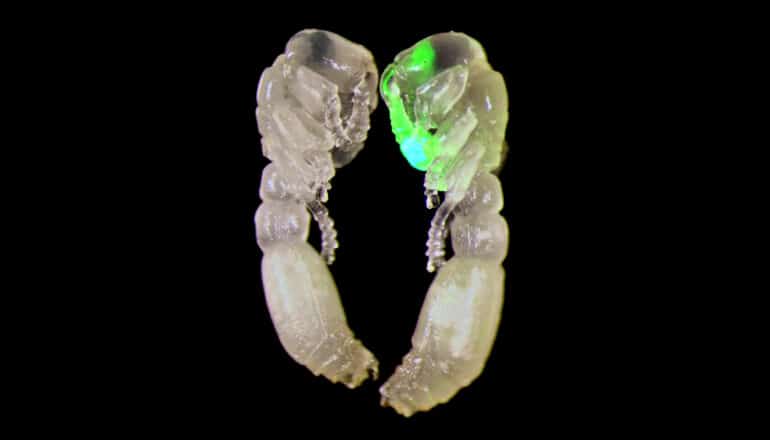
The world’s first transgenic ants have olfactory sensory neurons that flash green in response to odorants.
Ants navigate their richly aromatic world using an array of odor receptors and chemical signals called pheromones. Whether foraging or defending the nest, mating or tending to their young, ants both send and receive chemical signals throughout their lives. And the ant brain is well equipped to process the abundance of scents: The olfactory processing center in the ant’s brain has 10 times as many subdivisions as those of fruit flies, for example, even though their brains are about the same size.
And yet how the ant olfactory system encodes scent data has remained largely unknown.
Contrary to previous findings, the new study in Cell finds that only a few specific areas of the olfactory system lit up in response to alarm pheromones, danger signals that elicit panic and nest evacuation. The results raise questions about how sensory information is processed in the ant brain—as well as tantalizing possibilities for revealing what hundreds of other odorant receptors are up to.
“Neurogenetic tools have revolutionized the field of fruit fly neuroscience over the past decades, while social insect neuroscience has essentially been stuck,” says Daniel Kronauer, head of the Laboratory of Social Evolution and Behavior at Rockefeller University. “Our technical breakthroughs now finally allow us to apply these powerful tools in ants to study their social behavior.”
In 1958, E. O. Wilson reported that a secretion from the mandibular gland of harvester ants triggered their nestmates to quicken their pace and take up colony defense behaviors. He called this response “alarm behavior.” Since then, scientists have documented that alarm behavior and many other complex social activities in ant colonies are regulated by a vast array of pheromones.
Ants’ olfactory receptors are located on neurons in their antennae, which send their input to brain centers called the antennal lobes. The antennal lobes are comprised of specialized structures called glomeruli that are essential to scent processing. Some ants have more than 500 glomeruli—a bounty thought to be related to their heightened ability to perceive and discriminate between pheromones. Previous work from Kronauer’s lab has shown that ants whose odorant receptors have been knocked out cannot respond to pheromone signals.
In this study, the researchers created their transgenic subjects by injecting the eggs of clonal raider ants—a queenless species composed entirely of blind female workers—with genetic material encoding the synthetic protein GCaMP, which lights up neon green when calcium levels change during cellular activity.
“Our goal was to get GCaMP expressed only in a single cell type—the olfactory sensory neurons,” says lead author Taylor Hart, a researcher in Daniel Kronauer’s lab.
This was important because the antennal lobe is composed of multiple cell types: sensory neurons, projection neurons that carry sensory data to other parts of the brain, and lateral interneurons that link everything together. “Those other cell types can make signal-to-noise ratio poor, because they can be doing other activities, such as computations, processing information, and modulating signals,” Hart says. All of this can obscure what the olfactory neurons are doing.
While successfully breeding a small group of ants with GCaMP expression in the olfactory sensory neurons, the team also developed a sophisticated two-photon calcium imaging technique that allowed them to record neural activity throughout the entire antennal lobes of live ants for the first time.
The researchers decided to focus on alarm pheromones, because they are particularly volatile and elicit strong and robust behavioral responses. They found that adult ants that detected the scents immediately scrambled to gather as many eggs in their mandibles as they could and then made a break for it, fleeing into an adjacent section of the test chamber.
Hart and her team then used their new techniques to monitor GCaMP fluorescence levels in the antennal lobes of 22 transgenic ants as they exposed them to a range of odors, including the alarm pheromones (which smell fruity to the human nose). The flashes clustered in six glomeruli in one region, suggesting that area may act as the brain’s panic button.
“We were expecting that a large portion of the antennal lobe would show some kind of response to these alarm pheromones,” Hart says. “Instead, we saw that the responses were extremely localized. Most of the antennal lobe did not respond at all.”
Hart says the findings reveal details about how the ant brain processes sensory input. Researchers have wondered whether the activity is privatized, with each glomerulus responding only to one or a few specific stimuli, or distributed, with unique combinations of glomeruli activated by a stimulus. A brain with more than 500 glomeruli that operated in a distributed way, with hundreds of sensors firing at once, would need extraordinary computational power when it comes to sensory processing, Hart says.
“Most of the odors we tested activated only a small proportion of the total glomeruli,” she says. “It seems that privatization is the way in the ant antennal lobe.”
Considering that only six glomeruli responded out of 500, Hart wonders, “What do they need all these different glomeruli for? The fruit fly gets by with just 50.”
It will now be easier to find out why ants have a greater need to differentiate odor stimuli than other insects, Kronauer says—and not only because Hart has since bred hundreds of transgenic ants who differ from their wild counterparts only in their ability to signal in fluorescence, providing a robust pool for future research.
“The tools that Taylor developed open up a really big range of questions that were inaccessible to us until now,” he says. These include associating specific glomeruli with the variety of pheromones ants use for things like raiding, recruitment, and distinguishing between nestmates and outsiders. “There are also interesting developmental questions about how the ant olfactory system gets assembled, because it’s so complex. Larvae also have olfactory sensory neurons, so now we can look at their sensory capabilities.”
Source: Rockefeller University
The post Transgenic ants glow in response to alarm pheromones appeared first on Futurity.
I was trolling the olde blog settings for the WordPress Jetpack plugin and spotted something that confirmed I had aleady learned– the nuking of Twitter’s API meant the Social module could no longer tweet new posts.
Old news.
But what I did see was a new option to connect my WordPress blog to publish new posts to Mastodon. In like 10 second I connected to my instance and connected my account to this here blog.
Thus, this post is mostly a test of the connection (for which I spent more than too much time in Photoshop on the fetured image).
This might end up double tooting, since I have been using an IFTTT applet to share to mastodon whenever there is a new post in my RSS feed.
Ok, let’s see how this elephant flies with a new Jetpack!
Dead bird dead bird.
I’m no super billionaire businessman, but to cut off the world’s largest web publishing platform from adding content to your product is— dumb ass to the nth degree.
Toot, toot, someone sweep the dead bird off the road.
I have two mastodon post tooters in operation now… for comparison:
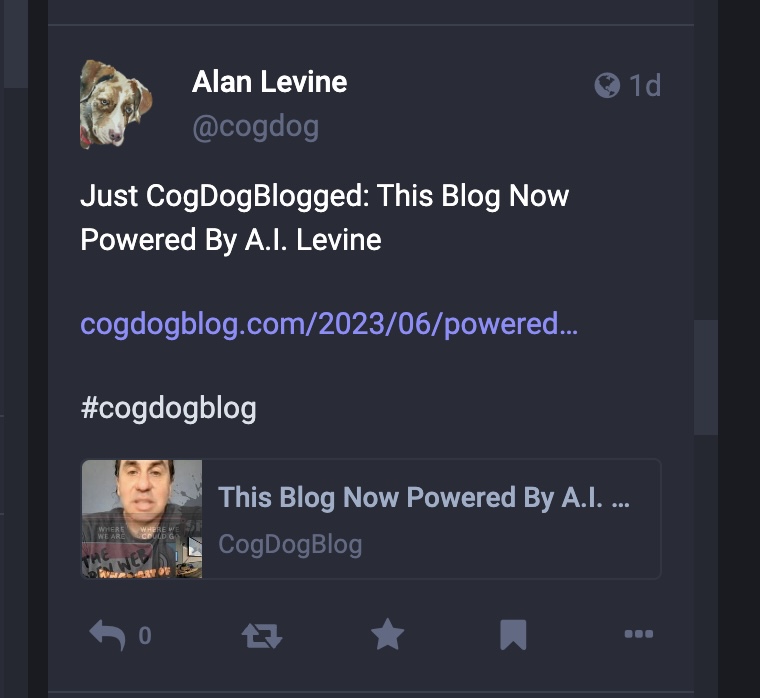

The difference is minor- the Jetpack on includes an excerpt of the post. I like in IFTTT I can customize it with extra text like before the title “Just CogDogBlogged” and adding an extra hashtag. I could include the excerpt in IFTTT but am not sure it matters. Also, IFTTT is a bit delayed, the JetPack one is instant. As if I am that important that I don’t want to keep my fan waiting.
I don’t think it means a hill of beans to anyone except me. I like IFTTT more, but I can use JetPack if the former ever poops out.
Featured Image: My own photoppery (OMG the crap DALL-E gave me for “An elephant wearing a jetpack hovers in the air over a dead bird laying on the road, cartoon style”) based on p1210759 flickr photo by generalising shared under a Creative Commons (BY-SA) license and Dead bird flickr photo by indoloony shared under a Creative Commons (BY-NC-ND) license

The Oxfordshire Blue Plaques Board has honored philosophers Philippa Foot and Iris Murdoch with plaques at their former homes.
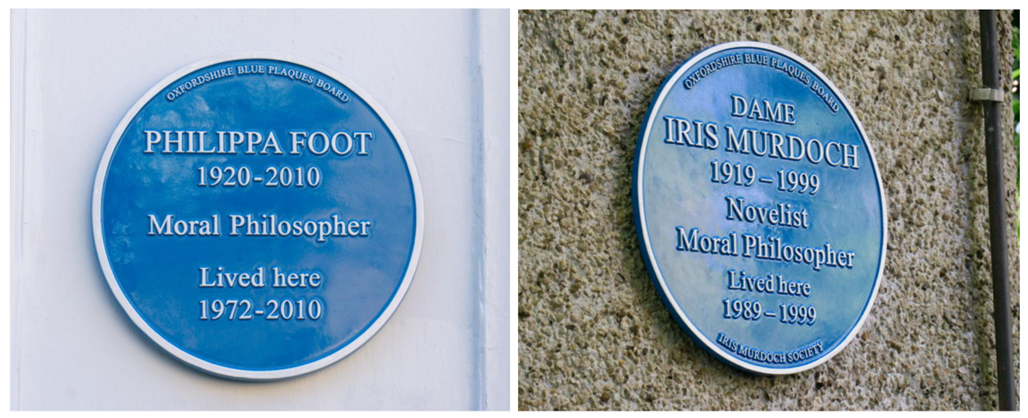
The Blue Plaques program “promotes recognition and awareness of people, places and events that have been of lasting significance in the life of Oxfordshire or more widely.”
You can see a list of other Blue Plaque honorees here.
The post Foot & Murdoch Honored With Plaques in Oxfordshire first appeared on Daily Nous.
On March 20, 2003, the United States invaded Iraq, and shortly thereafter, Ghaith Abdul-Ahad became an accidental journalist. Originally trained as an architect, he fell in as a translator with a group of foreign journalists, then as a photographer and war reporter for The Guardian and The Washington Post. In his new book, A Stranger in Your Own City, Abdul-Ahad documents the devastation of Baghdad, from the sanctions of the 1990s to the aftermath of Saddam Hussein’s fall. Punctuating his account are revealing interviews with his fellow Iraqis—Sunni commanders, schoolteachers, old high school friends, insurgents of every stripe—about the war and its effects, which continue to shape life in the region years after the American withdrawal.
Go beyond the episode:
Some of Abdul-Ahad’s illustrations from the book:







Tune in every week to catch interviews with the liveliest voices from literature, the arts, sciences, history, and public affairs; reports on cutting-edge works in progress; long-form narratives; and compelling excerpts from new books. Hosted by Stephanie Bastek. Follow us on Twitter @TheAmScho or on Facebook.
Subscribe: iTunes • Stitcher • Google Play • Acast
Download the audio here (right click to “save link as …”)
Have suggestions for projects you’d like us to catch up on, or writers you want to hear from? Send us a note: podcast [at] theamericanscholar [dot] org. And rate us on iTunes! Our theme music was composed by Nathan Prillaman.
The post Twenty Years of War appeared first on The American Scholar.
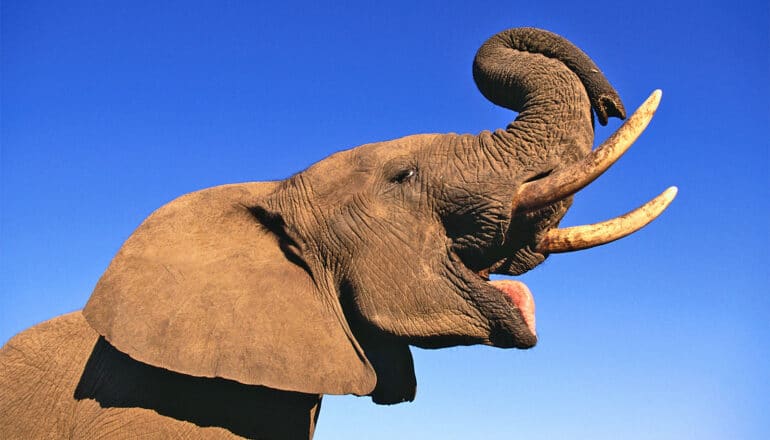
African elephants use their acute sense of smell as a form of communication, researchers report.
Professor Louw Hoffman from the University of Queensland’s Queensland Alliance of Agriculture and Food Innovation co-led a study of elephants in wildlife parks in Malawi, which found that smell was used to distinguish characteristics including age, health, reproductive status, and family relationships between elephants.
“We tested the DNA, glands, urine, and manure of 113 African elephants to identify family groupings,” Hoffman says.
“We found a number of chemicals were common to group members, but others that were unique to each individual.
“Elephants never mate with a sibling, even if they’ve been separated for years and can tell a strange elephant is close by from the smell of their manure or other excretions.”
Hoffman says social behavior also suggests elephants use odor to monitor other pachyderms, both within and outside their herd.
“We observed elephants greeting each other by squealing and flapping their ears,” he says.
“We believe they’re pushing their pheromones towards the other elephant as a sign of recognition.
“When elephants charge each other flapping their ears, rather than making themselves look bigger, we believe they’re blowing their pheromones as a warning not to mess with them.”
Hoffman says elephants not only identify different smells quickly, but also retain them in their memory.
“Some of the animals in the study were bred in captivity, and one of the tricks they’d been taught was to take a tourist’s hat and smell it,” he says.
“When the tourist came back hours later the elephant would be able to immediately identify who the hat belonged to.”
Hoffman says elephants could be trained to sense many things, including blood and explosives.
“These findings show elephants are complex creatures, and sound is not their only form of communication,” he says.
“We see humans as the apex, but we now know elephants are one of many animals that have senses more finely attuned than ours.
“There is a lot we can learn from the elephant.”
The study was co-led by Katharina von Dürckheim and Alison Leslie from the University of Stellenbosch.
The research appears in Scientific Reports.
Source: University of Queensland
The post African elephants use smell to communicate appeared first on Futurity.
Three philosophers have been named 2023 Guggenheim Fellows.
They are:

Stephen Darwall, Jennifer Morton, and Susanna Siegel
The fellowships are for 6-12 months, with monetary awards of varying amounts, and are given with no strings attached. There were 180 new fellows announced. You can view the entire list of them here.
A few philosophers have picked up grants from the National Science Foundation (NSF) recently.
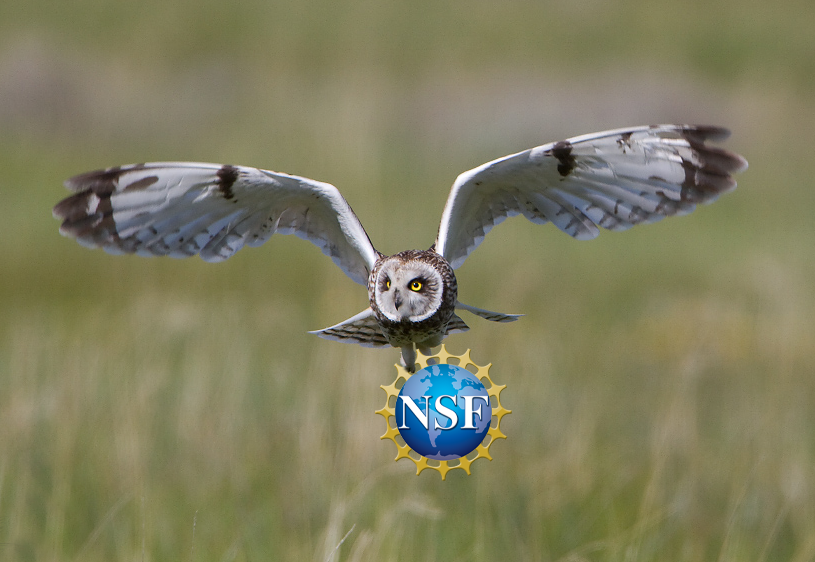
They are:
You can learn more about NSF grants here.
(Previous post about NSF grant winners is here.)
Oron Shagrir, professor of philosophy and cognitive and brain sciences at the Hebrew University of Jerusalem, is the winner of the 2023 Covey Award.

The Covey Award, presented by the International Association of Computing and Philosophy (IACAP), “recognizes senior scholars with a substantial record of innovative research in the field of computing and philosophy broadly conceived”.
The IACAP says: “The board recognised Professor Shagrir’s significant contribution to our field over several decades; in particular, his contribution to theories of computation.”
He will present the Covey Award Keynote Address at IACAP 2023 conference this July in Prague.
You can learn more about Professor Shagrir’s research here.
A list of previous winners of the Covey Award is here.
The Joseph Levenson Prize is awarded by the Association for Asian Studies to “the English-language books that make the greatest contribution to increasing understanding of the history, culture, society, politics, or economy of China.”
This year’s prize contest recognized books published in 2021, and honorable mention in the pre-1900 category was awarded to Tao Jiang, (a philosopher in the Department of Religion at Rutgers University, and director of the university’s Center for Chinese Studies) for his book, Origins of Moral-Political Philosophy in Early China (Oxford University Press).

It appears that Professor Jiang’s book is one of the few philosophy titles recognized in the history of the Levenson Prize since its inception in 1987.
Here’s a description of the book:
This book rewrites the story of classical Chinese philosophy, which has always been considered the single most creative and vibrant chapter in the history of Chinese philosophy. Works attributed to Confucius, Mozi, Mencius, Laozi, Zhuangzi, Xunzi, Han Feizi and many others represent the very origins of moral and political thinking in China. As testimony to their enduring stature, in recent decades many Chinese intellectuals, and even leading politicians, have turned to those classics, especially Confucian texts, for alternative or complementary sources of moral authority and political legitimacy. Therefore, philosophical inquiries into core normative values embedded in those classical texts are crucial to the ongoing scholarly discussion about China as China turns more culturally inward. It can also contribute to the spirited contemporary debate about the nature of philosophical reasoning, especially in the non-Western traditions.
This book offers a new narrative and interpretative framework about the origins of moral-political philosophy that tracks how the three normative values, humaneness, justice, and personal freedom, were formulated, reformulated, and contested by early Chinese philosophers in their effort to negotiate the relationship among three distinct domains, the personal, the familial, and the political. Such efforts took place as those thinkers were reimagining a new moral-political order, debating its guiding norms, and exploring possible sources within the context of an evolving understanding of Heaven and its relationship with the humans. Tao Jiang argues that the competing visions in that debate can be characterized as a contestation between partialist humaneness and impartialist justice as the guiding norm for the newly imagined moral-political order, with the Confucians, the Mohists, the Laoists, and the so-called fajia thinkers being the major participants, constituting the mainstream philosophical project during this period. Thinkers lined up differently along the justice-humaneness spectrum with earlier ones maintaining some continuity between the two normative values (or at least trying to accommodate both to some extent) while later ones leaning more toward their exclusivity in the political/public domain. Zhuangzi and the Zhuangists were the outliers of the mainstream moral-political debate who rejected the very parameter of humaneness versus justice in that discourse. They were a lone voice advocating personal freedom, but the Zhuangist expressions of freedom were self-restricted to the margins of the political world and the interiority of one’s heartmind. Such a take can shed new light on how the Zhuangist approach to personal freedom would profoundly impact the development of this idea in pre-modern Chinese political and intellectual history.
The winning book this year is by historian Ruth Mostern (Pittsburgh): The Yellow River (Yale University Press), a 3000-year history of China’s Yellow River.
You can learn more about the prize, including its previous recipients, here.
The Journal of Applied Philosophy has awarded its 2022 Best Essay Prize to Scott Altman (USC).
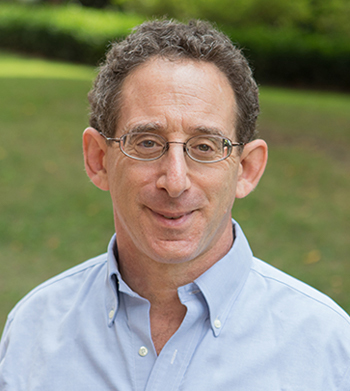
Professor Altman won the prize for his article, “Selling Silence: The Morality of Sexual Harassment NDAs“. Here’s its abstract:
This article argues against enforcing sexual harassment nondisclosure agreements (NDAs). Although NDAs guard privacy, facilitate settlement, and compensate victims, they also help repeat perpetrators avoid detection and punishment, endangering future victims and undermining efforts to combat sexual harassment. Advocates argue that victims have no duty to prevent these harms, given the risks and trauma of reporting. I offer three responses. First, although most victims have no duty to speak, some victims might come to have such a duty. The state should not help them commit to violating a future duty. Second, some initially reticent victims may later want to disclose. The state should not enforce promises not to do supererogatory acts. Third, NDAs make victims complicit with the perpetrator’s future harassment and wrongful efforts to avoid social punishment. If perpetrators refuse to compensate victims adequately without NDAs, we should increase victim compensation rather than enforce NDAs. Accused harassers might claim they need NDAs to guard against wrongful or excessive social punishment. For guilty perpetrators, NDAs resemble felony expungement statutes. However, arguments for expungement do not apply to NDAs. Although falsely accused people have legitimate privacy interests, NDAs are an excessively broad way to protect this interest.
The prize of £1,000 is awarded to the author of the best paper published in the journal that year, as judged by journal’s editors.
A list of previous winners of the prize is here.
Hanging out. All of us could probably stand to do more of it, especially if it doesn’t come with a calendar invite. In her new book, Hanging Out: The Radical Power of Killing Time, Sheila Liming writes that she’s found herself “an accidental witness to a growing crisis: people struggling to hang out, or else voicing concern and anxiety about how to hang out.” The coronavirus may have heightened this struggle, but its root causes—our increased obsession with our phones, the shrinking of public spaces, widening income inequality, American individualism—predate the pandemic. Liming, a professor of communications at Champlain College, joins us on the podcast to discuss both what we have to lose by not spending unstructured time together and how we can get it back.
Go beyond the episode:
Tune in every week to catch interviews with the liveliest voices from literature, the arts, sciences, history, and public affairs; reports on cutting-edge works in progress; long-form narratives; and compelling excerpts from new books. Hosted by Stephanie Bastek. Follow us on Twitter @TheAmScho or on Facebook.
Subscribe: iTunes • Stitcher • Google Play • Acast
Download the audio here (right click to “save link as …”)
Have suggestions for projects you’d like us to catch up on, or writers you want to hear from? Send us a note: podcast [at] theamericanscholar [dot] org. And rate us on iTunes! Our theme music was composed by Nathan Prillaman.
The post The Art of Doing Nothing Much, Together appeared first on The American Scholar.
